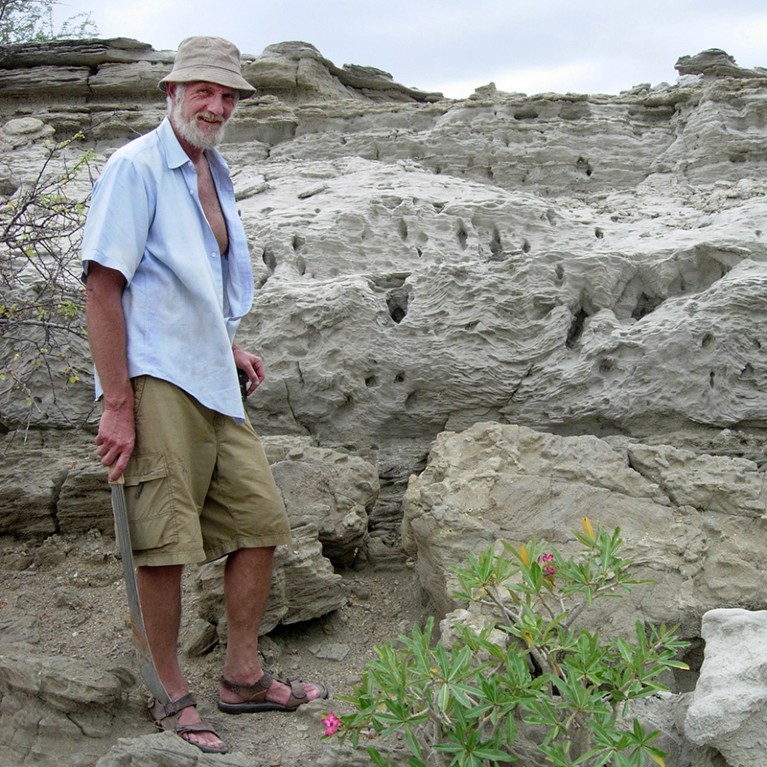
Frank BrownCredit: Thure Cerling
Although not a palaeoanthropologist, Frank Brown played a major part in unveiling the story of human evolution. He devoted half a century to working out the complex geology of the fossil-rich sediments of East Africa’s Omo–Turkana Basin, one of the key sources of information about early human evolution. By matching up the chemical signatures of volcanic ash layers identified at sites across the basin, Brown provided a reliable way to place fossil and archeological finds in chronological order, adding immeasurably to what we know about human origins.
Brown, who was born on 24 October 1943, grew up on a small family farm in northern California, tending animals and vines, building fences and chopping wood. These early lessons honed practical skills that came in handy in his subsequent fieldwork in remote regions of Africa. Brown attended the University of California, Berkeley, where he majored in geology, and stayed on for graduate studies. A year after he was awarded a PhD, in 1971, Brown moved to the University of Utah in Salt Lake City. There he rose through the academic ranks, eventually serving as dean of the College of Mines and Earth Sciences for just over a quarter of a century. He turned out to be an unusual, but remarkably successful, administrator. Not many deans make quince jelly, let alone hand-deliver it to their staff for the holiday season. He died unexpectedly on 30 September in Salt Lake City, aged 73.
As with many scientists, much of Brown’s success was the result of being in the right place at the right time. In the 1960s, the palaeoanthropologist Louis Leakey had persuaded the Emperor of Ethiopia to allow a team of Kenyan, French and US scientists to look for fossils in the lower reaches of the Omo River in southern Ethiopia, just north of what is now called Lake Turkana. Clark Howell, who would lead the US contingent, needed an intrepid geologist to go to Ethiopia a year before the main expedition to map the region’s sediments. He asked his colleague Garniss Curtis for advice, and Brown, who was then a research assistant in the Curtis lab, volunteered his services, setting out for the Omo Valley in the spring of 1966.
Brown became the lead geologist for the US team. He cut his teeth by working out the stratigraphy north of the lake, which fortunately turned out to be the simplest part of the region: the sediments were neatly stacked, with few gaps to complicate their interpretation. By 1968, Richard Leakey, Louis’s son and the leader of the Kenyan contingent, had abandoned the Omo in favour of Koobi Fora — an area with more fossils, on the northeast shore of Lake Turkana. In 1980, frustrated that several teams had failed to make sense of the site’s more complex sedimentary history, Leakey invited Brown to come to the area and extend his mapping project.
At Koobi Fora, periods of erosion had wiped away some sediments, complicating attempts to match the area’s sedimentary sequence with those of better understood, and better dated, sites in the north. In addition, a disputed radiometric date for some layers of volcanic ash, or tuffs, had suggested that the fossils at Koobi Fora were particularly old. Tempers were running high over what became known as the KBS tuff controversy. Brown inherited the stratigraphic equivalent of a train wreck.
The good news was that ash layers were present both at Koobi Fora and at the Omo River site. Brown reasoned that because each volcanic eruption has a unique mix of elements, if he took samples of the tuffs back to his lab and examined them in enough detail, down to the level of each microscopic shard of glass, he could assemble a unique chemical fingerprint for each eruption.
Brown and his colleagues discovered that what had been interpreted as distinct tuffs at different sites across the basin were actually the result of a single volcanic eruption. Because each tuff was like a ‘time blanket’ thrown over the region, fossils from different sites could be placed in a reliable temporal sequence. Koobi Fora was no longer an outlier.
Brown would walk miles on the off-chance that he would find purer samples of a tuff. His willingness to do so in inhospitable terrain, over an area half the size of his adopted home state of Utah, has resulted in a uniquely rich understanding of the region’s geological evolution and dynamics.
The Omo–Turkana Basin has yielded spectacular finds, including the most complete skeleton yet of Homo erectus; the earliest known stone tools; and the best evidence for many iconic species, including Australopithecus anamensis, Australopithecus boisei and Homo habilis. This region is not necessarily where humans originated, but it is one of the few places where erosion provides us with a precious window on to their evolution. Thanks to Brown’s work, we now have a coherent timeline for the region that stretches back several million years.
Brown’s work habits were the stuff of legend. He spent as little time as possible in urban areas, driving as soon as he could, and as fast as he could, into the landscape that was both his laboratory and his passion. In the half century of his geological work in southern Ethiopia, Brown became an expert on its flora and fauna, and took the trouble to learn the languages of its people — many of whom became his friends. He was incredibly self-sufficient: a minimum of supplies, his panga machete and the company of his African field assistants were all he needed. There was almost nothing he could not fix.
Brown’s exacting regime of laboratory analyses and old-fashioned ‘boots on the ground’ geological mapping has enabled researchers — and will continue to enable them — to use the Omo–Turkana Basin to better understand our evolutionary history.

 Ethiopian jawbone may mark dawn of humankind
Ethiopian jawbone may mark dawn of humankind







